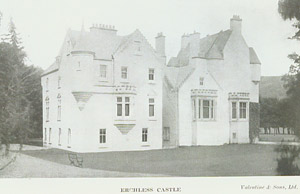WordPress database error: [Got error 28 from storage engine]
SELECT t.*, tt.*, tr.object_id FROM wp_terms AS t INNER JOIN wp_term_taxonomy AS tt ON tt.term_id = t.term_id INNER JOIN wp_term_relationships AS tr ON tr.term_taxonomy_id = tt.term_taxonomy_id WHERE tt.taxonomy IN ('category', 'post_tag', 'post_format') AND tr.object_id IN (61405) ORDER BY t.name ASC
Clan Chisholm History

Erchless Castle in the Highlands. It was built by the Bisset clan in the 13th century, but passed to the Chisholms through marriage in the 15th century. It remained in the family until the estate was sold in 1937
This name is formed from the Norman ‘chese’ which meant ‘to choose’, and ‘holm’ which is a Saxon word that meant ‘meadow’.
The kingdom of Gododdin was taken by the Northumbrian English in the 7th century and then taken in turn by the Normans three hundred years later. The early Chisholms came across the North Sea and the lands they claimed in Roxburghshire became a feudal barony.
The name of Alexander de Cheschelme appears on a charter from 1249, and the Ragman Roll of 1296, listing the supporters of England’s Edward I mentions Richard de Cheschelme and John de Cheshome. The seal used by the family shows a boar’s head which represented the traditional story of two Chisholm brothers who saved a king from a wild boar.
This symbol is used in Chisholm heraldry today. By 1359 the family had gained the post of constables of Urquhart Castle, the important royal stronghold on the shores of Loch Ness that guarded the pass to the western highlands.
The various Chiefs of the Clan of Strathglass and Glen Cannich were known as ‘The Chisholm’. One of them would say that only three people on earth were entitled to use the definite article for their appellation: The Pope, The King and The Chisholm.
Less than fifty of the Chisholms who fought for Prince Charles at Culloden survived. Three of the seven men who shepherded the Prince away across the country were Chisholms: Alexander, Donald and Hugh. Hugh vowed, after shaking the Prince’s hand at the end of their journey, he would never shake another man’s hand. He kept his vow for life.
Twenty-second chief Ruairidh, in the mid 1700s, followed the chiefs of other clans of the time by squeezing his tenants for as much rent as he could. The pressure was relieved for a generation upon his death but William, twenty-third chief in 1793, burned his family’s loyal supporters out of their homes to make way for sheep.
Clan Chisholm Posts






